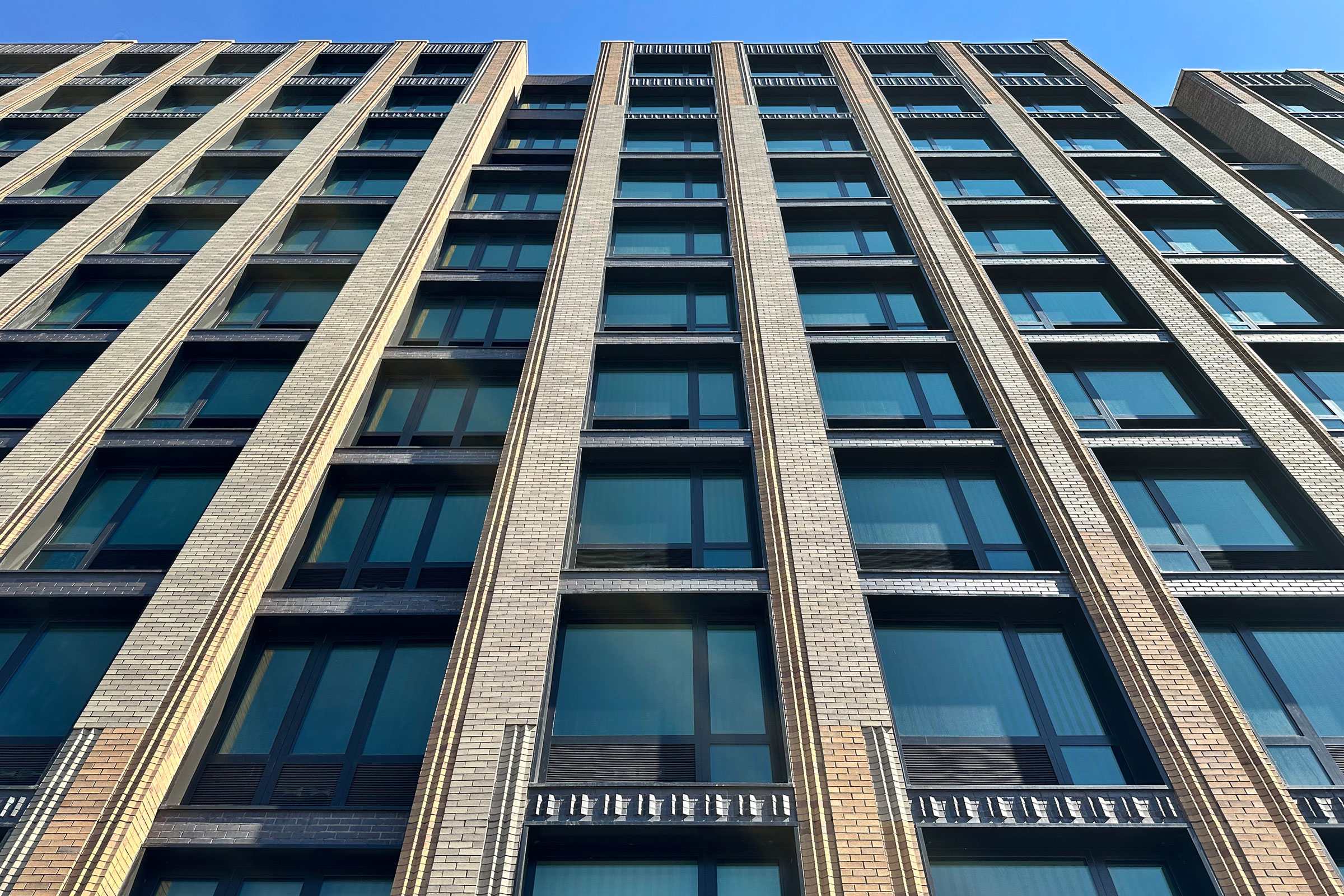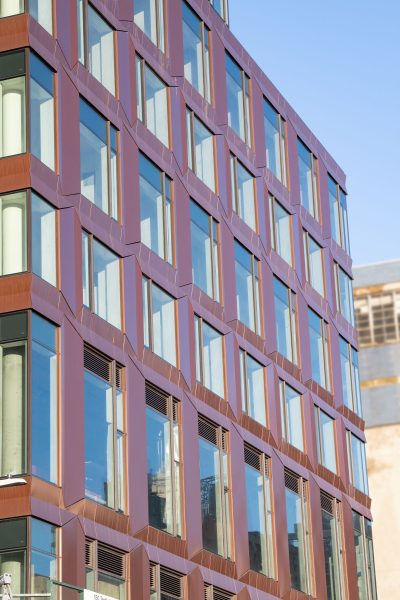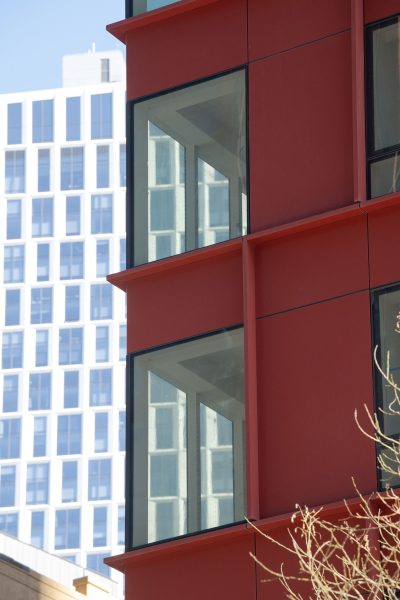Story at a glance:
- Bird-friendly glass offers increased energy efficiency and more benefits in the latest innovations.
- Recent research shows bird deaths from collisions far surpass previous estimates—more than one billion annually in the US alone.
- New solutions to reduce bird collisions with glass can offer very low visibility to humans when compared to alternatives.
- Guardian Glass plans to launch Jumbo Bird1st UV in 2025, increasing availability for this patterned coating to a 130-by-204-inch glass lite.
“Nobody is intentionally designing buildings to harm birds, but it does take some foresight to design a building that helps not to,” says Heidi Trudell, bird-friendly specialist and regional technical advisor with Guardian Glass.
Trudell is the first ornithologist to work at the major manufacturer—one of the many signs of their commitment to stewardship and its environmental aspect. Guardian continues to conduct research and work to develop innovative solutions for buildings while also placing a large emphasis on educating the architectural and construction communities on how different bird-friendly glass technologies can be incorporated within their projects.
In North America bird populations are down roughly 30% since the 1970s, with current estimates pointing to at least 2 billion birds killed per year from colliding into buildings, Trudell says. The American Bird Conservancy (ABC), the National Audubon Society, Cornell University, and all major bird research organizations cite glass as having the highest human-caused risk to birds, aside from outdoor cats—but there is a solution to the problem.
While many in the industry were initially in denial that collisions were an issue, that has changed. Now birds are a common part of many design considerations. “I’m most excited about how normal it is now; the bird-friendly conversation used to be a real niche,” says Dan Piselli, director of sustainability and a principal at FXCollaborative. “Now it’s something everybody has to deal with. That’s particularly good for me because I’m interested in all sustainability issues, and I see the bird collision issue as one manifestation of the negative human impact on our climate and our environment.” Climate change is abstract, he says, manifesting in greater storm intensity or wildfires that can be hard to directly connect. Hundreds of birds hitting the same facade, though, shows a clear correlation.
Piselli says the topic is more prevalent in part because there are now more products on the market to address it. “It’s about specifying something now. There’s less mystery. Back when I was first introduced to the issue the experts were not sure what the successful strategies were going to be. Now after many years and examples, it’s better.”
Because there are more products available—many of them with little aesthetic impact—and a stronger understanding of the issue, designers can do the right thing with little effort, Piselli says. “I hope greater awareness of human impact on the environment and climate change is driving more sustainability-focused design generally,” he says. “Obviously everybody is preoccupied with operational energy and human health, or lately embodied energy, and that’s all right, but part of a comprehensive approach also includes addressing ecology issues like reducing bird collisions or promoting pollinators with landscapes that help them thrive.”
Trudell says reducing pressure on birds is critical because those populations can recover if changes are made. She says voluntary bird-friendly standards are gaining traction, and while building code requirements, bylaws, and incentivization are happening largely in Canada, the US is catching up. Codes now exist in Europe and Korea as well. Approximately 50 municipalities in Canada have requirements on the books and roughly 40 in the US have active or pending codes, she says. Cities like Portland, Maine have acted, and Austin, Boulder, Denver, and Nashville could be next, she says.
Detailed Solutions
- Guardian Bird1st UV is a highly innovative, bird-friendly glass that helps to prevent bird collisions with buildings. Photo by Alexander Sobolev
- Guardian Bird1st Etch offers acid-etched patterns. Photo by Alexander Sobolev
“We are now asking glass to do more than we ever have before, especially for the exterior envelope,” says Alan Kinder, director of commercial segment at Guardian Glass. “We see a continued tightening of industry standards that are challenging us to develop new coatings that meet more stringent U-value and SHGC requirements. We see Jumbo glass capabilities and the request for oversized glazing units grow at an increased rate.”
Enhanced acoustics, improved safety and security, and impact protection are product-specific variables Guardian discusses as part of the glazing unit configuration, Kinder says. Embodied carbon and stewardship initiatives also influence specifications and material selections, and adding the much needed component of bird-friendly solutions is pushing the industry and Guardian in particular to continue to provide innovative technologies that solve many challenges. “Beyond the product and material development, we also are having to ensure effective transfer of knowledge and the ability to provide project-specific custom content to help architects, building owners, and consultants make the proper material selections that check all the boxes,” Kinder says.
Guardian Bird1st UV is among the latest innovations. Bird1st UV helps to prevent bird collisions with buildings using a UV coating with a striped pattern that’s nearly invisible to humans but visible to birds. The alternating UV reflecting stripes on the outside surface of the glass with a UV absorbing laminate material really makes the UV contrast pop, Trudell says.
FXCollaborative uses a variety of strategies depending on project needs, including Bird1st on multiple projects recently. Guardian’s Bird1st UV requires a #1 surface placement to increase the efficacy to mitigate bird collisions. Different lighting and viewing conditions can impact the visibility level of all deterrents. Even with the worst case of bright reflected sky on the exterior, the visibility of Bird 1st UV to humans is low. “It’s still subtle,” Piselli says.
Guardian also offers Bird1st Etch, a surface 1 acid etch in patterns that meet ABC’s 2-by-2-inch spacing requirements (not to be confused with abrasive etch or laser etch). Trudell says the pattern spacing is critical because birds know their own dimensions and what they can or can’t fly between.
Beyond the benefits to birds, though, Trudell says these products may also offer benefits to building occupants, including outstanding thermal performance, lower maintenance costs (nobody has to clean up after collisions, and pests are not attracted to the site), as well as increased mental, emotional, occupational productivity (no one is witnessing collisions or having their meetings disturbed by them).
Kinder says Guardian is on the leading edge with research and innovation, especially with product test methodologies and comparative metrics. “We are continuing to innovate to develop a suite of products that provide the best range of coverage to meet performance and aesthetic demands while also ensuring an efficient supply of material,” he says. Guardian Glass plans to launch Jumbo Bird1st UV in 2025, increasing availability for this patterned coating to a 130-by-204-inch glass lite.
Important Testing
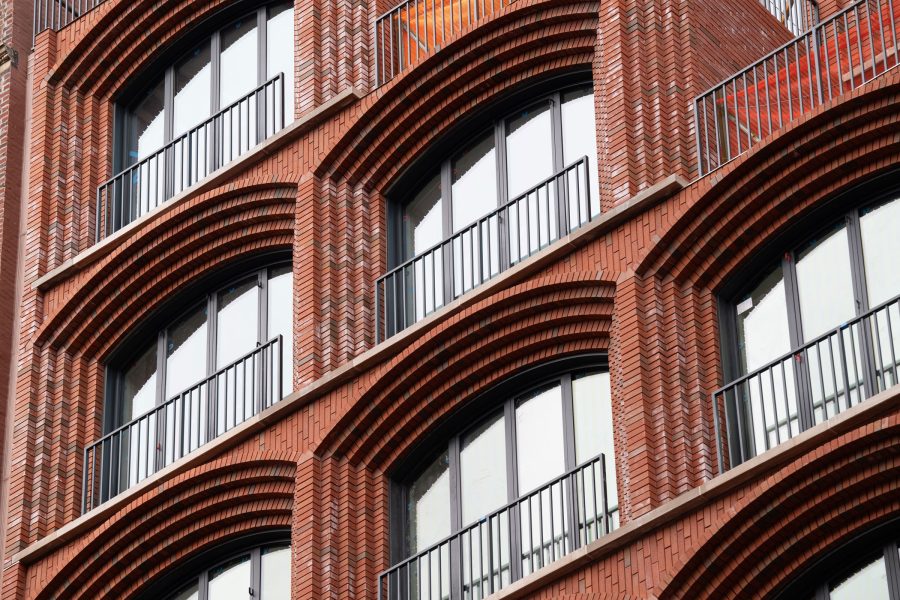
Bird1st UV’s alternating UV-reflecting stripes on the outside surface of the glass with a UV-absorbing laminate material make the UV contrast pop, preventing bird collisions. Photo by Alexander Sobolev
Guardian already had a couple of bird-friendly products at the time Trudell joined, and those offerings have only grown after she and the R&D team did field trips to explore how birds act in the environment. “One of the reasons I am working for Guardian is that they do their homework,” she says. “They have solicited not only input from biologists, but also all of these products get assigned a Material Threat Factor score through the American Bird Conservancy. Guardian also asks, ‘What can we learn or improve from all the other testing methodologies that are available?’”
This is important, she says, because the collisions research field is just starting to refine its understanding of the many variables that impact a solution’s performance and how context-specific they can be. “Right now it’s still a little bit of the Wild West because architects are working under the assumption that every solution is going to work equally well in every installation. This is not accurate. Every deterrent technology ever made works differently in different visual environments,” she says. “For example, a black frit color might work great as a deterrent against a bright background but have significantly less efficacy against a dark background. The collisions world is still in the early years of discovering all of these relationships, and future embodiments of testing and regulations will likely be more sophisticated than the ones we have today.”
Even within a technology category, similar sounding solutions might not work the same. There are material differences between different types of etch that impact the visual contrast for birds, so acid etch versus laser etch versus abrasive etch will not have the same efficacy as each other, for example.
Nothing is low-risk unless you intentionally design it to be low-risk using products that are bird-friendly.
“If you look at the field of UV in general this is especially true because every manufacturer has a completely different approach to UV,” Trudell says. Guardian takes the time to push the limits of UV deterrent technology in a good way. “You’ve got the increased contrast between the super high UV reflective coating (~75%) and total UV absorber (>99%). That boost in contrast is only possible if the UV reflector is on surface 1 with the absorber on surface 2, and Guardian makes sure all of their IGU makeups have that proprietary boost.”
Trudell says best practices are changing rapidly to keep up with evolving technology. “I have to update all of my product information and reference materials every four to six months.” While concrete and steel have been understood for centuries, float glass wasn’t really a thing until 1960. “Not only was float glass a very new technology, but understanding that birds hitting it was even a problem was a very new thing as well.”
She says architects have an obligation to tell their clients about the environmental impact of their buildings according to the AIA 2018 code of ethics. Collisions are part of that broader concept, but architects often don’t know the information, and Guardian can help them understand and improve their designs for birds. “When people ask me about a design, the first thing I do is look at a geographic location and take into consideration what species move through the area. We have to look at a landscape level very immediately as well as in terms of what the habitat is around the building. No building is exempt,” she says. “You have to toddler-proof your building from the outside, and your toddlers are hummingbirds. Certain variables can make your building more high-risk, but really nothing is low-risk unless you intentionally design it to be low-risk using products that are bird-friendly.”
An Architect’s Perspective
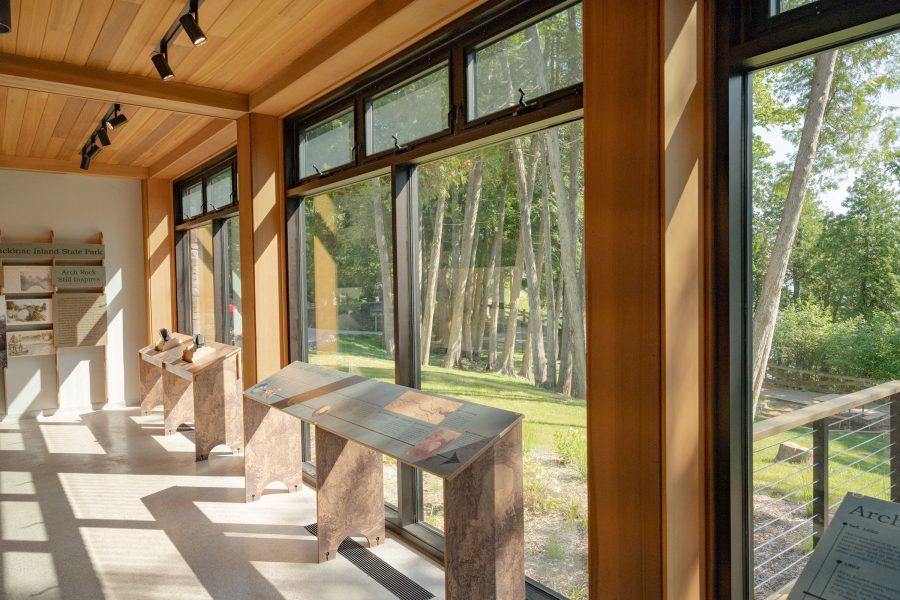
The UV product has little impact on the interior view at Milliken Nature Center. Photo by Alexander Sobolev
Piselli has been with FXCollaborative for 19 years, working first on the Center for Global Conservation at the Bronx Zoo—an experiment in designing a bird-safe building. “That building ended up being a test case for certain strategies,” he says. “It was a great learning opportunity.” They learned, for example, that overhangs or awnings were in fact not good collision mitigation strategies.
The 2013 renovation of Manhattan’s Jacob K. Javits Center, however, was a huge success. It was the first time a major New York City building was retrofitted with bird-friendly glass, according to the NYC Bird Alliance. The renovation by FXCollaborative and Epstein in consultation with NYC Bird Alliance resulted in a drop in bird-building collisions at the site of more than 90%.
“We replaced all the glass at the Javits Center with a kind of glass that had a frit pattern on it,” Piselli says, adding that the pattern provided several benefits. It was bird-safe, and it reduced the solar heat gain to minimize energy use for air conditioning. The frit also allowed for a non-tinted glass, which Piselli says is much clearer even with the frit, so you can see in and out of the building much better. “The frit also reduced glare, so there were a number of co-benefits of that fritting strategy, which included but were not limited to being bird-friendly.”
Since the Javits Center project FXCollaborative has had a number of projects complete similar objectives, often pairing solar heat gain reduction through fritting as an added benefit of collision mitigation. While bird-friendly solutions were relegated to commercial and institutional clients for some time, that changed when NYC Local law 15 of 2020 got passed. At first Piselli says residential clients worried people wouldn’t want to lease apartments with frit. “Now we have a whole crop of residential buildings that have bird-friendly glass on them. Different clients have used different solutions, and we’ve been able to see what’s working well.”
Piselli has been involved with the Bird-Safe Buildings Alliance for more than a decade, helping to create the bird-friendly guidelines from its first iteration in 2007. The biggest challenges today, he says, are cost and aesthetics, but improvements continue to be made. “Aesthetics is a real challenge because a lot of it comes down to personal preference,” he says. “Some people don’t mind seeing horizontal lines, and some people hate that and like dots instead. Some people like dots in a rectangular pattern. We did a custom pattern that was essentially in the form of dotted lines at the Statue of Liberty Museum, and that’s successful because we were very deliberate with the view, creating a vertical dot line pattern that was going to blend in better with the surroundings than other patterns.” Today that project sees maybe one collision a year, he says.
More Than One Billion Birds
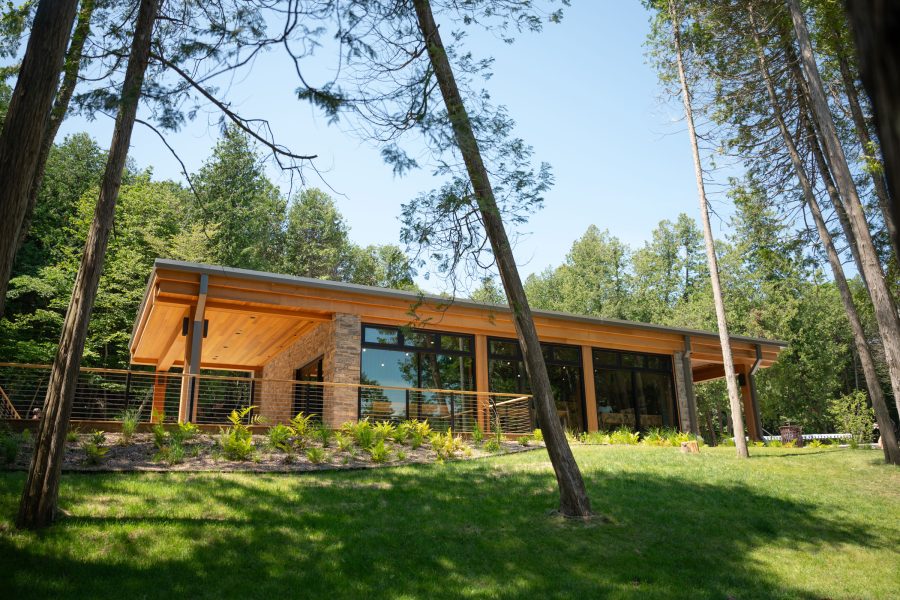
The Milliken Nature Center features Bird1st glass. Photo by Alexander Sobolev
Recent research shows bird deaths from collisions far surpass previous estimates—more than one billion annually in the US alone—highlighting an urgent need for bird-safe glass retrofits and artificial light reduction measures, according to ABC.
The findings revealed only 40% of birds with injuries from collisions survive, even with the highest standards of wildlife rehabilitator care, suggesting current mortality estimates based solely on birds found dead at collision sites vastly undercount the true toll. “Birds generally cannot see or recognize glass. When they see vegetation or the sky reflected in windows, they perceive it as habitat and do not know there’s a barrier in the way that they cannot fly through,” says senior author Kaitlyn Parkins of ABC. “The good news is people can help. For existing buildings and homes the easiest fix is to add inexpensive, commercially available bird-safe window treatments such as those tested by ABC.”
Piselli hopes the continued visibility of the issue will push people to make change, as people get interested in issues when they’re up close. A nature lover himself, he recalls various bird collisions close to him that were unsettling. They began to add up, even just from his own experience. “The scale of this issue has become apparent, and once you realize you can do something about it and it can have co-benefits with other sustainability strategies, and it can look good, it’s like, why not?”

